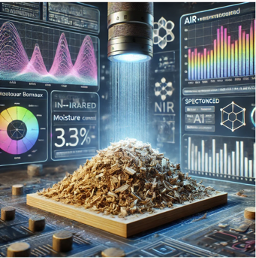With the growing global demand for renewable energy and the increased use of forest residues left behind or burned after harvesting, the wood pellet industry is looking into optimizing feedstock. While using forest biomass holds great promise, it also brings challenges such as contamination, ash and moisture content variability and higher processing costs.
The Wood Pellet Association of Canada (WPAC) and The University of British Columbia’s Biomass and Bioenergy Research Group (BBRG) are developing Artificial Intelligence (AI) assisted Near-Infrared (NIR) technology specifically for use in the wood pellet sector. This tool could significantly improve the efficiency of biomass sorting, leading to higher-quality pellets and reduced operational costs.
Biomass Sorting Challenges
Biomass feedstock comes from diverse sources, including forest residues, recycled wood and agricultural waste. Each source presents challenges, ranging from inconsistent moisture levels and particle size variations to chemical contaminants. These factors can negatively impact combustion efficiency, pellet durability and product quality.
Current methods for sorting and blending biomass often do not account for these variations in real-time, resulting in inefficiencies, higher energy consumption and greater wear and tear on equipment.
How AI-Enhanced NIR Technology Works
NIR technology operates by shining near-infrared light on biomass feedstock and analyzing the light reflected to determine molecular composition. This allows real-time measurement of key properties, including moisture content, chemical composition, particle size, contaminants and impurities.
The integration of AI algorithms enhances the precision of NIR technology by providing advanced data interpretation, real-time decision-making and automatic adjustments to the feedstock blend. This ensures biomass entering a pellet plant meets stringent quality requirements, such as those outlined in ISO 17225-2.
Benefits for Pellet Production
- Improved Feedstock Quality: By rapidly assessing and adjusting the biomass blend, NIR technology ensures moisture and chemical composition uniformity, leading to higher-quality pellets.
- Increased Production Efficiency: AI-driven real-time monitoring minimizes the need for manual adjustments, reducing waste and optimizing energy consumption.
- Expanded Biomass Utilization: NIR technology allows pellet plants to efficiently process a broader range of underutilized materials, such as burnt wood, forest residues and recycled wood fibre.
- Reduced Maintenance Costs: The ability to detect impurities early prevents damage to equipment, extending the life of machinery and minimizing downtime.
- Cost Savings: Enhanced sorting accuracy reduces material waste and energy consumption, translating to significant cost reductions over time.
Real-World Applications and Future Potential
The AI-assisted NIR technology system currently under development by WPAC and BBRG will be tested through pilot programs at WPAC members’ pellet plants to evaluate its effectiveness in improving feedstock sorting and plant efficiency. Following these pilots’ success, this technology’s deployment will be scaled up across operations. By integrating AI-enhanced NIR systems into the pellet production process, the aim is to boost efficiency, enhance product consistency, and maintain competitiveness in the evolving biomass industry.
Looking ahead, AI-NIR technology’s potential extends beyond pellet production. Its adaptability makes it applicable in other sectors of the biomass industry, such as biofuel production and biochemical processing.
A New Era for Biomass
AI-enhanced NIR technology represents a pivotal shift in how biomass feedstock could be managed. Providing a fast, reliable method for sorting and blending biomass offers a clear path toward greater efficiency, sustainability and profitability in pellet production.
Dr. Fahimeh Yazdan Panah is the Director of Research and Technical Development, Wood Pellet Association of Canada

